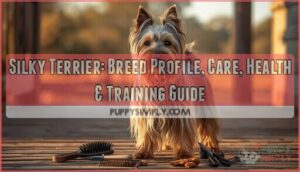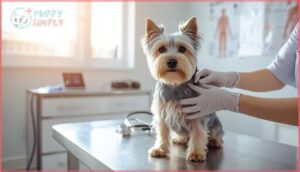This site is supported by our readers. We may earn a commission, at no cost to you, if you purchase through links.

Don’t let the flowing locks and delicate name fool you—the Silky Terrier packs serious attitude into an 8-11 pound frame. Born from a bold Australian experiment crossing Yorkshire and Australian Terriers in the late 1800s, this breed inherited the best of both worlds: striking beauty and fearless independence.
That glossy coat might suggest a pampered lap dog, but underneath beats the heart of a true terrier—alert, spirited, and ready to take on the world. If you’re drawn to their elegant appearance, you’ll need to match their grooming demands with an understanding of their tenacious personality.
These compact companions thrive when you respect both their need for structure and their fierce sense of self.
Table Of Contents
- Key Takeaways
- Silky Terrier Breed Overview
- Physical Characteristics of Silky Terriers
- Health and Common Medical Concerns
- Grooming and Maintenance Needs
- Training, Exercise, and Daily Care
- Frequently Asked Questions (FAQs)
- What is the recommended grooming routine for a Silky Terrier?
- How often should a Silky Terrier be bathed?
- What is the best way to trim a Silky Terrier’s coat?
- What are the common health issues in Silky Terriers?
- How can I train my Silky Terrier effectively?
- Can Silky Terriers be left alone during work hours?
- How do Silky Terriers behave around cats?
- What toys are best for Silky Terriers?
- Do Silky Terriers bark excessively or cause noise?
- Conclusion
Key Takeaways
- The Silky Terrier is an 8-11 pound Australian breed born from crossing Yorkshire and Australian Terriers in the late 1800s, combining striking beauty with a fearless, independent terrier temperament that demands both consistent training and respect for their strong-willed nature.
- Despite their elegant appearance and silky coat, these dogs require significant daily maintenance, including brushing 2-3 times weekly, bathing every 2-4 weeks, and 30-60 minutes of exercise, plus they’re prone to specific health issues like patellar luxation, dental disease (affecting 80% by age two), and eye conditions.
- Their high prey drive and alert watchdog instincts mean they’ll bark frequently, chase anything that moves, and need to stay leashed outdoors—but with proper socialization starting between 3-13 weeks and positive reinforcement training, they become fiercely loyal companions.
- Silky Terriers thrive in apartments and city living when given structured routines and consistent exercise, making them ideal for active owners who understand that their 13-15 year commitment involves meeting both the grooming demands and the mental stimulation needs of a true terrier personality.
Silky Terrier Breed Overview
If you’re drawn to a dog that packs serious personality into a pint-sized package, the Silky Terrier might just steal your heart. This Australian breed brings together striking looks, fierce independence, and surprising athleticism in one glossy, ten-pound bundle.
Let’s explore where this spirited little terrier comes from, what makes them tick, and whether they’re the right match for your lifestyle.
Breed Origins and History
The Silky Terrier emerged from late 19th-century Australia when breeders crossed Yorkshire Terriers with Australian Terriers to improve coat texture and blue-tan coloring. This terrier heritage blended working farm dog roots with urban companion appeal.
Dandie Dinmont Terriers occasionally contributed to breed development, softening coats and enhancing topknots. By the 1920s, these Australian roots produced a distinct breed with historical significance as both vermin controller and beloved pet.
The breed’s development is guided by the official breed standards to maintain its unique characteristics.
Recognition by Kennel Clubs
Once Australian breeders established their vision, kennel clubs took notice. The American Kennel Club formally registered the Silky Terrier in 1959, placing it in the Toy Group despite its terrier heritage. The United Kennel Club followed in 1965, classifying it as a true terrier. Meanwhile, the Fédération Cynologique Internationale assigned breed number 236, cementing FCI recognition.
Club membership and AKC standards now guide breeders worldwide in preserving these distinctive breed characteristics. Breeders must consider the dog breed standards to guarantee the Silky Terrier’s unique traits are maintained.
Typical Temperament and Personality
Temperament and personality set this breed apart. Your Silky Terrier brings high-spirited energy paired with strong affection levels—the AKC rates them five out of five for family bonds.
These intelligent dogs learn quickly yet display stubbornness traits that demand consistent training. Their playful nature keeps you entertained, while keen alertness makes them reliable watchdogs.
Social behavior shines with familiar faces, though their terrier instincts mean they won’t back down easily.
Suitability for Families and Living Situations
That feisty spirit translates into specific living needs. Your Silky Terrier thrives in diverse family dynamics, yet certain situations work better than others.
Best matches for this small dog:
- Active families with older children who understand gentle handling
- Urban living enthusiasts ready for daily 30-45 minute walks
- Single-pet households where territorial behaviors won’t spark conflict
- Apartment dwellers committed to managing their watchdog barking through consistent training
Space requirements stay modest—your commitment matters more than square footage.
Physical Characteristics of Silky Terriers
The Silky Terrier’s appearance is what sets it apart from other toy breeds—it’s got a distinct look that’s both elegant and spirited. From the signature coat that gives the breed its name to the compact frame and alert expression, these physical traits tell you a lot about what you’re getting.
Let’s break down the key characteristics that define how your Silky will look and why they matter.
Size and Weight
You might expect a toy dog to be pocket-sized, but the Silky Terrier strikes a balanced middle ground. Adult weight usually sits between 8 and 11 pounds, with most reaching around 10 pounds at full maturity. Height measures 9 to 10 inches at the shoulder, making them larger than Yorkshire Terriers yet more refined than Australian Terriers.
Their body proportions run about one-fifth longer than tall, creating that signature low-set, agile silhouette perfect for small dog enthusiasts seeking breed standards in terrier breeds.
Coat Texture and Colors
That silky texture you’ll feel when you run your hands through the coat isn’t just marketing—it’s the breed’s defining trait. The single-layer coat resembles human hair, straight and glossy, parted down the back with a lighter topknot framing the face. Blue and tan coloring develops by 18 months, replacing puppy black.
- Low shedding makes this toy dog appealing for allergy-conscious homes
- Coat maintenance requires daily brushing to prevent mats in fine hair
- Grooming tips: bathe every 2-4 weeks and trim for neat silhouette
Head, Ears, and Tail Features
A wedge-shaped skull, slightly longer than the muzzle, gives the Silky Terrier its signature alert look. Those small, V-shaped ears sit high and stand erect—never droopy—framing almond-shaped dark eyes that miss nothing.
The high-set tail, docked or natural, carries between twelve and two o’clock when your dog’s excited.
A fine topknot crowns the head, lighter than the tan facial markings, while proper grooming keeps hair from obscuring that piercing gaze.
Distinguishing Traits Vs. Other Terriers
At 9 to 10 inches tall and 8 to 10 pounds, your Silky Terrier stands taller than a Yorkshire Terrier but smaller than an Australian Terrier.
The breed distinctions go deeper than size variance—Silkies sport a broader muzzle, more sturdy frame, and straighter coat that never touches the floor.
Energy levels run higher too, demanding 30 to 45 minutes of daily exercise compared to a Yorkie’s 20.
Health and Common Medical Concerns
Silky Terriers are generally healthy little dogs, but like all breeds, they’re prone to certain medical conditions you should know about. Understanding these potential health issues helps you spot warning signs early and keep your pup in top shape.
Here’s what you need to watch for throughout your Silky’s life.
Life Expectancy
Your Silky Terrier can be your sidekick for 13 to 15 years—sometimes longer if you play your cards right. Here’s what shapes their longevity:
- Genetic influence from responsible breeding reduces inherited health problems
- Preventive care through regular vet visits catches issues early
- Dental hygiene combats the breed’s tendency toward periodontal disease
- Weight management keeps joints healthy and aging graceful
- Daily exercise maintains both physical and mental sharpness throughout life
Patellar Luxation
Kneecaps that slip out of place—patellar luxation—rank among the top health problems for your Silky Terrier. This dog health issue affects up to 7% of small breeds, with luxation grades ranging from mild (I-II) to severe (III-IV).
Surgical options boast success rates near 100% for early grades, restoring joint stability and canine anatomy. Recovery times span 8-16 weeks, depending on severity.
Legg-Calve-Perthes Disease
Another joint problem your Silky Terrier might face involves the hip, specifically Legg-Calve-Perthes Disease. This dog health issue strikes young toy breeds between 4 and 6 months, causing interrupted blood flow to the femoral head. You’ll notice gradual limping and muscle wasting as canine health deteriorates—watch for these disease symptoms:
- Pain when you touch the affected hip
- Reluctance to bear weight on one hind leg
- Clicking or popping sounds during movement
Hip surgery (FHO) offers 93-96% owner satisfaction, with most dogs recovering within 4-6 weeks. Genetic factors play a role, though pain management and early intervention dramatically improve your dog’s prognosis. Detecting health issues early makes the recovery process smoother for these spunky dog breeds.
Dental Health and Disease
Beyond joint problems, your Silky’s small mouth creates a perfect storm for tooth decay and gum disease. About 80% of these pint-sized pups develop periodontal issues by age two—their crowded teeth trap plaque like nobody’s business.
Daily brushing with dog-specific paste and regular dental chews keep oral hygiene on track. Skip professional cleanings, and you’re risking canine health issues that affect far more than just their smile.
Eye Conditions (Cataracts, PRA)
Dental woes aren’t the only health battle your Silky faces—eye problems like cataracts and progressive retinal atrophy (PRA) can steal their sight if you’re not vigilant. Cataracts affect over 10% of the breed, while PRA causes night blindness in most affected dogs. Regular eye exams catch these conditions early, and cataract surgery can restore vision when you act fast.
- Cataracts appear 6x more often in Silky Terriers than mixed-breed dogs
- PRA symptoms usually emerge around age 8-9, starting with night vision loss
- Early eye exam tips include watching for cloudy pupils or bumping into furniture
- Vision loss prevention starts with annual canine ophthalmology screenings
- Genetic testing helps breeders reduce inherited eye problems in future litters
Preventive Veterinary Care
Catching problems before they spiral keeps your Silky thriving for years. Annual check-ups should include vaccine schedules, parasite control, and health screenings—especially blood work and dental prophylaxis every 6-12 months. Senior dogs need twice-yearly visits to monitor organ function and canine health trends.
Your vet’s nutrition counseling ensures balanced dog health through proper feeding, while preventive care reduces emergency visits by 30-35% across all dog breeds.
Grooming and Maintenance Needs
That gorgeous, silky coat doesn’t maintain itself—your Silky Terrier needs consistent grooming to stay healthy and looking sharp. From brushing routines to dental care, each part of the grooming process plays a role in your dog’s overall well-being.
Here’s what you need to know to keep your Silky in top condition.
Brushing and Bathing Routines
Your Silky’s luxurious coat demands consistent attention—think of pet grooming as a daily ritual, not a chore. Brushing techniques matter: use a pin brush followed by a comb two to three times weekly, focusing on those tricky spots behind the ears and under the legs. For bathing schedules, aim for every 2–4 weeks with a gentle, hypoallergenic shampoo to keep coat maintenance straightforward and effective.
Key grooming tools and detangling methods:
- Apply detangling spray before brushing to reduce breakage and simplify grooming and hygiene routines
- Work through stubborn mats slowly with fingers or a metal comb—never cut them
- Blow-dry thoroughly after each bath, brushing as you go to prevent moisture-related tangles
Daily grooming techniques take just 7–10 minutes but make all the difference in keeping that silky texture radiant and mat-free.
Coat Trimming and Shedding
Unlike double-coated breeds, your Silky Terrier sheds minimally—just 0.5 to 1 gram weekly—making them nearly hypoallergenic with proper coat maintenance. Shedding patterns peak slightly during spring and autumn, but consistent grooming frequency and dog grooming practices keep loose hair practically invisible compared to most terriers.
Professional trimming techniques every 4–6 weeks keep that single-layer hair texture manageable, while home scissoring of stray ends maintains breed standards.
Nail, Ear, and Dental Care
Beyond the coat, your Silky needs nail trimming every 2–4 weeks to prevent joint strain, ear cleaning biweekly with vet-approved solutions to dodge infections, and daily dental hygiene—brushing with canine toothpaste combats the tartar accumulation that plagues small breeds.
Preventive measures beat emergency vet visits: annual veterinary checkups catch issues early, while consistent pet grooming and nutrition routines keep your terrier thriving long-term.
Managing Mats and Tangles
Fine, silky hair tangles faster than you’d think—most Silkies develop mats within three days without brushing. Daily sessions with a slicker brush or pin brush prevent up to 50% of severe matting. Focus on friction zones: behind ears, under legs, and collar areas.
Use detangling spray on damp coats before brushing, and never cut close to skin. Professional grooming every 6–8 weeks keeps your terrier’s coat impeccable.
Training, Exercise, and Daily Care
Don’t let that silky coat fool you—this breed packs terrier energy and attitude into a toy-sized package. Your Silky needs consistent training, daily exercise, and a routine that keeps both mind and body busy.
Here’s what you need to know about raising a well-adjusted, happy Silky Terrier.
Training Techniques and Socialization
Your Silky Terrier’s bright mind thrives on positive reinforcement—think treats, praise, and clicker training to lock in obedience commands and curb that terrier stubbornness. Puppy socialization between 3 and 13 weeks is your golden window for behavioral modification success. Focus on:
- Enrolling in puppy kindergarten classes early
- Exposing your pup to varied sights and sounds
- Using short, upbeat training sessions
- Rewarding calm behavior around new dogs
- Establishing consistent house rules from day one
Exercise Requirements and Activity Levels
Your energetic dog needs 30–60 minutes of daily exercise—two brisk walks plus active play sessions like fetch or tug keep energy levels balanced. Indoor brain games and puzzle feeders add essential mental stimulation when outdoor time is tight.
Undershooting these exercise needs invites obesity, joint strain, and destructive behavior. Puppies under 12 months should stick to shorter bursts to protect growing bones, while seniors benefit from gentler, consistent physical activity.
Diet and Nutrition Tips
Feeding your Silky right takes more than tossing kibble in a bowl. Split 80–100g of food into two daily meals, prioritizing animal-based protein requirements at 22% minimum and fat intake between 8–15%. Nutrition advice for canine health and wellness starts here:
- Fresh water accessible 24/7 bolsters hydration needs
- Joint-supporting nutrient supplements like omega-3s boost coat shine
- Limit treats to 10% of calories
- Adjust meal frequency and portions as your dog ages
Prey Drive and Leash Use
Your Silky’s hunting heritage means squirrels, birds, and darting cats trigger an unstoppable chase impulse. Always walk on leash—even well-trained Silkies ignore recall when prey appears.
Silky Terriers have unstoppable prey drive—always keep them leashed, as even trained dogs will bolt after squirrels and birds
Use a front-clip strap to cut pulling force by nearly half, and practice loose-leash training early. Consistent exercise before walks reduces lunging episodes, keeping both of you safer on city streets.
Adapting to City or Apartment Living
That leash discipline pays off in apartments, where most Silky Terriers thrive in under 60 square meters. Budget 60 minutes of daily walks split into morning and evening sessions—consistent exercise cuts problem barking by half.
Use puzzle toys between outings, keep hallway sightlines blocked, and warn neighbors about your terrier’s alert nature. City living works beautifully when you match their energy with structure.
Frequently Asked Questions (FAQs)
What is the recommended grooming routine for a Silky Terrier?
Your brushing routine shapes everything. Use a pin or soft bristle brush at least twice weekly to prevent tangles, maintain that glossy coat, and control shedding—daily during humid weather or outdoor adventures.
How often should a Silky Terrier be bathed?
Most owners bathe their dogs every four to six weeks to keep skin healthy and coats shiny. For your Silky Terrier, this grooming schedule balances hygiene with preserving natural oils.
What is the best way to trim a Silky Terrier’s coat?
Professional grooming every four to six weeks keeps the coat healthy.
Use clippers with a 10 blade for body areas, scissors for finishing, and blunt-tipped safety scissors near sensitive spots like ears and eyes.
What are the common health issues in Silky Terriers?
Toy breeds face serious dental risks, with over 80% developing disease by age two. Patellar issues, eye problems like cataracts, and genetic disorders require regular health screening to catch complications early.
How can I train my Silky Terrier effectively?
Like a sculptor shaping clay, you’ll mold your Silky Terrier’s behavior through Positive Reinforcement and Clicker Training. Start Obedience Commands early, focusing on consistent Dog Training Techniques.
Housebreaking Tips and Behavioral Correction prevent stubbornness from taking root.
Can Silky Terriers be left alone during work hours?
Small dog breeds with strong owner bonds shouldn’t be left alone more than six to eight hours daily.
Silky Terriers are especially prone to separation anxiety, so consider doggy daycare, interactive toys, or midday visits if you work full-time.
How do Silky Terriers behave around cats?
Terrier dogs often chase cats due to their prey drive, but early socialization strategies and cat introduction techniques can help.
With gradual household dynamics training, impulse control, and supervision, many coexist successfully as canine companions.
What toys are best for Silky Terriers?
Interactive puzzle toys, durable chews, and squeaky plush toys work best for engaging your Silky Terrier’s sharp mind and prey drive.
Fetch games and tug toys channel their energy while strengthening training and bonding.
Do Silky Terriers bark excessively or cause noise?
Does your dog need to announce every leaf that falls? Barking patterns in toy breeds often reflect deep-rooted vocal traits.
Silky Terriers bark frequently—alert watchdogs by nature, averaging over 20 daily episodes without proper sound management and dog training.
Conclusion
Beauty is only skin deep, and the Silky Terrier proves it daily. Behind that stunning coat lies a bold companion who won’t bend to convenience alone.
You’ll invest time grooming, training, and channeling their terrier instincts, but you’ll gain a fiercely loyal partner in return. They demand consistency, respect their independence, and never underestimate their spirit.
Meet those needs, and you’ll discover why this breed captivates owners who appreciate substance wrapped in elegance.
- https://www.webmd.com/pets/dogs/what-to-know-silky-terriers
- https://www.newsweek.com/these-are-least-popular-dog-breeds-america-this-year-1553996
- https://www.hillspet.com/dog-care/dog-breeds/silky-terrier
- https://en.wikipedia.org/wiki/Australian_Silky_Terrier
- https://www.houndsy.com/blogs/modern-tails/understanding-silky-terrier-health-problems-a-comprehensive-guide-for-pet-owners













